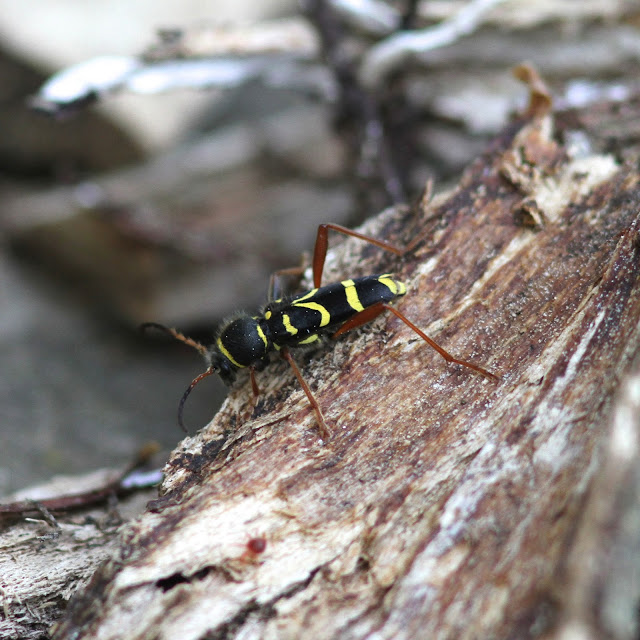I'm not aware that I have ever seen a cricket before last week. I found this beauty in Somerset. It is a Dark Bush Cricket, Pholidoptera griseoaptera.
Then three days later this one landed on me in Wiltshire. I think it is an Oak Bush Cricket, Meconema thalassinum. I managed only one photo on the iPhone in pouring rain under my umbrella.
My Blog List
Monday, 31 August 2015
Saturday, 29 August 2015
Bird of the week - Kingfisher
The kingfisher (Alcedo atthis) is one of our most extravagantly coloured birds. This young female was in Gosforth Park yesterday morning.
Her fishing technique needs some improvement - while I was watching she made several dives but the only thing she caught was a piece of reed.
Kingfishers cough up pellets made of indigestible fish bones and scales etc. Here the pellet is in mid air to her left, just over the branch she is sitting on.
The colours are quite amazing and vary with the light - sometimes more blue , sometimes more green. This one in bright early morning sunlight has a greenish colour.
Compare the colour with this adult female - taken previously with the same camera from the same viewpoint but in different light.
Kingfishers are not common birds - there are only around 5000 pairs in the UK - but they are found on rivers, lakes and streams across most of lowland Great Britain.
The population can plummet in harsh winters but recovers quickly when conditions improve. Overall it is stable.
Listen to the BBC Radio 4 Tweet of the Day on kingfishers here. Read more about kingfishers on the BTO site here.
Kingfishers cough up pellets made of indigestible fish bones and scales etc. Here the pellet is in mid air to her left, just over the branch she is sitting on.
The colours are quite amazing and vary with the light - sometimes more blue , sometimes more green. This one in bright early morning sunlight has a greenish colour.
Compare the colour with this adult female - taken previously with the same camera from the same viewpoint but in different light.
Kingfishers are not common birds - there are only around 5000 pairs in the UK - but they are found on rivers, lakes and streams across most of lowland Great Britain.
The population can plummet in harsh winters but recovers quickly when conditions improve. Overall it is stable.
Listen to the BBC Radio 4 Tweet of the Day on kingfishers here. Read more about kingfishers on the BTO site here.
Thursday, 27 August 2015
Rusty tussock moth caterpillar
I was on a landscape photography workshop in Dorset and was supposed to be making photographs of an avenue of beech trees when I was distracted by this caterpillar climbing up one of them. It is the larva of a Rusty Tussock Moth, also known as the Vapourer, and has the strange scientific name of Orgyia antiqua. The caterpillar has two black tufts of hair on its head, four bright yellow tufts along its back and an orange tuft at the rear.
The adults exhibit extraordinary sexual dimorphism, meaning that the two sexes look very different. The male is a handsome orange-brown moth with a white comma-shaped mark on each wing. The female looks like a furry woodlouse and is flightless. For more details and pictures of the adult moths click here.
I never did get a good photo of the beech trees.
The adults exhibit extraordinary sexual dimorphism, meaning that the two sexes look very different. The male is a handsome orange-brown moth with a white comma-shaped mark on each wing. The female looks like a furry woodlouse and is flightless. For more details and pictures of the adult moths click here.
I never did get a good photo of the beech trees.
Wednesday, 26 August 2015
Wasp beetle
The wasp beetle, Clytus arietis, is a harmless longhorn beetle that gains protection from looking and sounding like a wasp, another example of Batesian mimicry. It feeds on flowers and lays its eggs in dead wood.
Monday, 24 August 2015
More hawkers
Common hawkers in a mating wheel at Banks' pond.
This male southern hawker was on patrol on the woods at Gosforth Park Nature Reserve but stopped for a rest when the clouds came over. When the sun came out again I had a few moments for photos before he was off again. I think he has more blue colouration than usual.
Saturday, 22 August 2015
Thursday, 20 August 2015
Tuesday, 18 August 2015
More bees
When I visit a garden these days I spend more time looking at the bees than the flowers. There is one species of honey bee in this country, around 25 species of bumblebee (of which seven are common), and around 250 species of solitary bee. I can spot the honey bees, most of the bumblebees, and some of the solitary bees. There are plenty of solitary bees I'm not sure about. To illustrate the variety, here are a few I have seen recently.
Royal Mail has today issued a set of stamps depicting six rare bees, none of which I have seen. You can see the designs here.
Subscribe to:
Comments (Atom)





















































